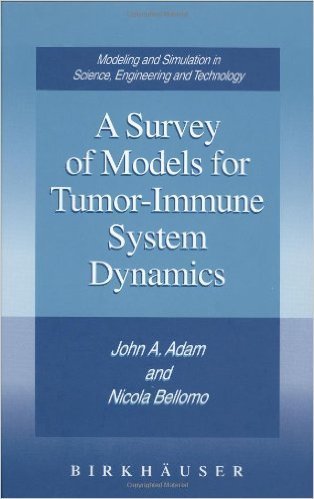
10.32 MB PDF
Preface
An enormous amount of human effort and economic resources has been directed in this century to the fight against cancer. The purpose, of course, has been to find strategies to overcome this hard, challenging and seemingly endless struggle. We can readily imagine that even greater efforts will be required in the next century. The hope is that ultimately humanity will be successful; success will have been achieved when it is possible to activate and control the immune system in its competition against neoplastic cells.
Dealing with the above-mentioned problem requires the fullest possible cooperation among scientists working in different fields: biology, immunology, medicine, physics and, we believe, mathematics. Certainly, biologists and immunologists will make the greatest contribution to the research. However, it is now increasingly recognized that mathematics and computer science may well able to make major contributions to such problems. We cannot expect mathematicians alone to solve fundamental problems in immunology and (in particular) cancer research, but valuable support, however modest, can be provided by mathematicians to the research aspirations of biologists and immunologists working in this field.
The interplay between mathematics and the natural sciences occurs in the arena of modeling complex systems and computer-aided simulations of analytic or numerical models. A mathematical model therefore finds its location midway between phenomenological observation and physical reality. It can be regarded as an attempt to provide a description of that reality by means of mathematical constructs and/or computational algorithms. It is not claimed that a model may precisely simulate physical reality, but that it may in some sense be a good approximation.
Ideally, then, mathematical models contribute to an understanding of the real system which is being modeled. Such simulation helps us to look at reality more deeply and with heightened understanding, but in many case, however accurate the observations and however sophisticated the experimental devices used for measurements may be, the system is still too complex to be deeply understood. A mathematical model may decompose the system into relatively simple elements and attempt to reproduce some particular behaviors of those elements. Eventually, it may contribute to a substantial understanding at least of some selected aspects of such a system.
Simulation provides the capability of visualizing the above-mentioned behaviors. This can be of considerable support to experimental research by reducing the cost of expensive experiments and shortening the investigation times. Thus the cost-effectiveness of collaboration between mathematicians and immunologists may be very high, especially in view of the potential social impact success would bring.
Ideally we anticipate that a physico-mathematical theory will eventually be available to describe the dynamics of the immune system and its competition with tumor cells. We are not close to this objective. It seems that it may be necessary to develop new mathematics (or at least, utilize other existing mathematical approaches) and design architectures in computer devices for such a purpose. Obviously it is necessary to make a serious commitment to this ultimate goal in order to promote high quality research. This collection of surveys was designed with the aim of addressing the above-mentioned objective. Although the final result is extremely distant, the surveys represent, it is to be hoped, a small but valuable step towards the desired outcome.
This book reports some of the current research modeling the interactions between tumor cells and the immune system. We hope that a synergistic collaboration between applied mathematicians and immunologists will become recognized by the broader scientific community. As a result of editing this book, we have become convinced that such collaborations are already developing.
The contents should also be of interest to applied mathematicians not currently in this field, who may nonetheless be stimulated by some of the new and challenging problems posed within the book. These problems often relate to qualitative analysis of initial and initial-boundary value problems associated with the models described in the book, as well as relating to the development of computational methods appropriate for quantitative analysis and simulation. Some of these problems are on the frontiers of applied mathematics.
If you found this book helpful then please like, subscribe and share.
Disclaimer
